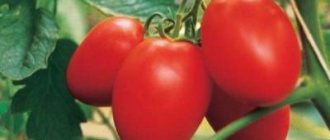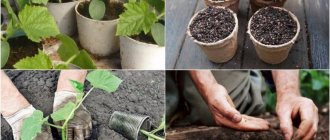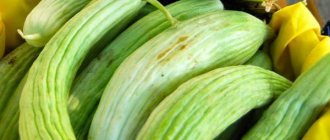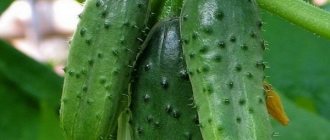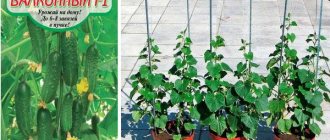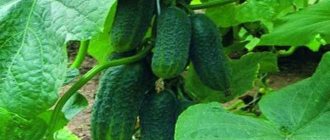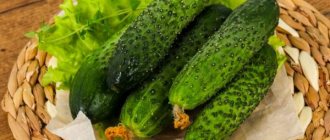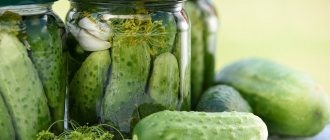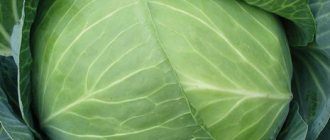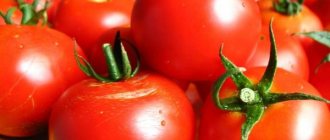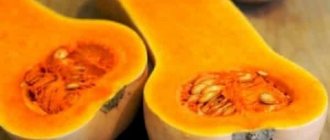Borisych F1 is a hybrid variety of cucumbers. Mid-early, self-pollinating and high-yielding. Bred by the originator A.A. Mashtakov. and in 2007 included in the State Register of selection achievements approved for use. Seeds are produced by Euro-Seeds in Russia, Ukraine and Moldova. In our country, varieties are grown in open ground and in greenhouses in many regions from North to South: in the North and North-West, in the Central, Volga-Vyatka and Middle Volga, in the Central Black Earth and North Caucasus.
Description and characteristics of the variety
Borisych F1 from is an indeterminate plant. The main vine reaches a length of 1.8-2.5 m. The flowers are female, self-pollinating (parthenocarpic). In one node, 2-3 fruits are tied, which ripen 38-45 days after seed germination.
The fruits are long, aligned, of the same shape, 18-20 cm long. Weight 150-180 g. The shape is slightly ribbed, the skin is covered with a large number of tubercles. The pulp is aromatic, juicy, crisp, with a slightly sweet aftertaste.
Diseases and pests
The Borisych F1 hybrid is resistant to many infections: powdery mildew, downy mildew, cucumber mosaic virus. However, this does not protect against insect pests. Therefore, when caring for bushes, do not forget about regular inspections of the plantings in search of ants, aphids, slugs and other insects that undermine the health of cucumbers.
Ants, creating their settlements, can interfere with the growth and formation of the root system of bushes. These small insects are carriers of aphids. To combat ants, you can use the following methods:
- plant garlic or mint next to the cucumbers, whose smells repel ants;
- sprinkle the soil between the beds with boric acid mixed with sugar to poison the ants;
- or use ready-made insecticides - Ant, Thunder;
- anthills can be filled with boiling water, and in the fall after harvesting, the ground can be treated with a solution of copper sulfate.
In August, aphids appear on cucumber leaves. These parasites feed on the juices of leaves and stems, simultaneously secreting poison. The following remedies are useful in combating them:
- spraying with garlic infusion, or red pepper tincture, or celandine decoction;
- treatment of plants with insecticides such as Iskra, Actofit.
Attention!
Excessive humidity promotes the appearance of slugs that eat young cucumber leaves.
Due to the fact that these mollusks appear at night, it can be difficult to detect them during inspections, much less collect them by hand. In addition to controlling moisture, you can use the following to combat them:
- fertilizers rich in potassium, in particular wood ash, they repel these pests;
- chemical insecticides - Slime eater, Thunderstorm, Ethisso.
Mole cricket is another pest that is not easy to detect. The insect lives in the ground and can feed on the roots of cucumbers, interfering with their growth and nutrition of the entire bush. The following methods are used to combat it:
- plant cilantro nearby, the smell of this herb repels the mole cricket;
- water the ground with a soap solution or a solution of washing powder - this will not kill the mole cricket, but will force it to crawl to the surface, and it can be collected by hand;
- use special insecticides - Grom, Medvetoks, Aktara.
It is better to treat plants with chemicals before fruiting. And then use herbal decoctions and sprinkling with wood ash.
If the plant is significantly affected by the disease, it would be preferable to dig up the bush along with the roots and throw it away, and treat the ground with a fungicide.
Landing
In the southern regions, it is better to plant seeds directly in open ground, and in cold climates, to grow seedlings.
Manure, peat and mineral fertilizers are added to the soil in the garden bed and dug up. The seeds are sown according to a 50 by 50 cm pattern and allowed to germinate under the film. In cold weather, you can build film huts for young bushes.
Milking seedlings will require pots of 300-500 ml. It is moved into the ground at the age of 30 days.
It is not recommended to plant vegetables in areas after other pumpkin and melon crops.
Advantages of the variety
The plant is distinguished by strong shoots that can withstand difficult growing conditions and a large number of cucumber fruits. Reviews from gardeners highlight the following description of the benefits of the variety:
- high yield rates;
- excellent taste of vegetables;
- lack of bitterness even in ripe fruits;
- ability to maintain richness of taste during storage;
- a pronounced cucumber aroma, giving salads an unusual piquancy of taste;
- stress resistance;
- high immunity to major diseases of cucumber crops.
The plant perfectly withstands the invasion of cucumber mosaic and powdery mildew. Its good ability to tolerate stress makes the variety suitable for cultivation not only by experienced, but also by novice gardeners. Due to the fact that the fruits are not miniature, the main use of the variety is considered to be use in salads.
See also
How to test cucumber seeds for germination in water at homeRead
Complete care
For “Perfection Itself” cucumbers, it is important to create the necessary conditions. They consist of implementing the following recommendations:
- Organic matter is added directly to the wells. This is done because the roots of the crop are small and located close to the surface.
- Air temperature 22–28 ⁰С.
- Mulching the beds will help retain moisture.
- Water with warm water in the evening.
- Feed with complex fertilizers.
- Carry out preventive treatments against diseases and pests.
If cucumbers grow without proper care, you should not expect the declared yield. In addition to following these recommendations, you should loosen, remove weeds, and tie the lashes to the supports.
Be sure to pinch the plant. This will increase the number of fruits. Technology:
- First of all, the cucumber lashes must be tied to the supports.
- After the main stem reaches a size of 0.5 m, the lower side shoots are removed, along with the ovaries and inflorescences. Subsequent shoots from the central trunk of the plant are retained.
- It is recommended to remove their growing point after 3–4 cucumbers have formed.
- After the central lash grows to the top of the support, you can lower it down. Then remove the growing point.
Basic ideas about the variety
A detailed description provides a lot of useful information to those who first decided to grow a crop on their own site. In particular, it will help to correctly position the plant on the site, applying the requirements of agricultural technology to obtain the declared yield.
- Belongs to the type of bunched plants.
- Parthenocarpic subspecies.
- Female flowers predominate.
- Medium branched.
- There are 5–6 ovaries in one sinus.
- Ripens in: 40–45 days.
- Fruits for a long time.
- Productivity: 10 kg per plant.
- Shape: cylindrical.
- Length: 10 cm.
- Green color.
- Thorns: white (non-prickly).
- Surface: lumpy.
- Taste: excellent, without bitterness.
Growing the Break cucumber variety
The hybrid cucumber variety Break was developed by Gavrish. Its peculiarity is that with minimal care, gardeners grow large, high-quality crops.
Growing the Break cucumber variety
Characteristic features of the variety
The fruits of cucumbers of the Break f1 variety grow up to 2 m in height. The foliage is moderate. The leaves are cylindrical, large. Their color is dark green. On the surface of the leaf plate there are white stripes reaching to the middle.
- the surface is covered with small white bumps;
- high density peel;
- cucumber length - 10 cm;
- average weight - 100-150 g;
- dark green color;
- diameter - 5 cm;
- Yield indicators are 15-20 kg per bush.
The pulp is juicy and has a good crunch. The inner seeds are small, soft, suitable for consumption. The taste is rich, sweet and sour. The aroma is characteristic of cucumbers.
Growing
The Break cucumber variety of category f1 is suitable for growing both using seedlings and without seedlings. High yields are achieved by planting with seedlings. To do this, seeds purchased in early March are placed in a manganese solution (4 g per 10 liters of water) and infused for 20 minutes. Afterwards, the seeds are washed under cold running water for about 2 minutes. When they dry a little, they are placed in gauze and sent to the freezer for an hour. This allows you to prepare planting material for negative environmental factors: changes in temperature or air humidity. After this, planting is carried out in containers according to a 7 cm x 9 cm pattern. The seed sowing depth should be 1 cm.
Containers are placed in a cool, dark place. The daytime temperature in the room should be 20°C-25°C, and the night temperature should be 13°C-17°C. This allows you to speed up the process of emergence of the first shoots. After they appear, the container is moved to the windowsill, where the seedlings will form evenly.
As soon as 4 main leaves appear on the seedlings, they are planted in a permanent place. The optimal time for this is considered to be the beginning of May.
Cucumbers need to be watered constantly
The Break variety is a cucumber hybrid that requires high-quality soil moisture. The watering interval is 3-4 days (for the Central and Southern regions of the country) or 7-10 days (for the Northern parts of the country). It is better to use a drip system, which will allow you to irrigate the root part. Drops of water should not fall on the leaves, otherwise they will begin to dry out.
After each watering, for better air exchange, the soil is loosened and weeds that carry pests and insects are removed.
Subcortex is carried out as the plant develops. 10 days after planting the seedlings, organic fertilizers are added to the ground: humus, compost or peat. For 1 sq. m should account for 2 kg of fertilizer. The second feeding is carried out at the beginning of flowering: potassium components are used (30 g of ammonium nitrate or 40 g of potassium nitrate per 10 liters of water). At the beginning of fruiting, phosphorus solutions are used (50 g of superphosphate per 10 liters of water).
When side shoots appear on the plant, the bush is blinded in the lower part, in the places where the first leaf is formed. Due to its tall growth, the bush requires regular garters. For this purpose, special high tension meshes are used. Excess shoots or leaves need to be removed, so you should carefully monitor the development of the plant. If you remove the tendrils on the bushes in time, large fruits will form.
Control of insects and diseases
The main disease that affects the Break variety is powdery mildew. A solution of Bordeaux mixture (20 g per 10 liters of water), which is sprayed weekly, helps to get rid of it. The remedy against olive or brown spot is a solution of the drug “Silk” (40 g per 10 liters of water). Colloidal salt (30 g per 10 liters of water) helps in the fight against blackleg.
An effective remedy against aphids is the drug “Hom” (30 g per 10 liters of water) or “Oxychom” (50 g per 10 liters of water). Spraying with a pepper solution (10 g of cayenne pepper per 5 liters of water) helps in the fight against fleas and slugs.
Reviews
- Anna Fedorovna, 60 years old: I immediately liked the name and made me laugh. I remember it. My husband is Ivan Borisych. That's exactly why I took it. I mostly grow tomatoes, but this year we also started growing cucumbers. I grew them before about 5 years ago. They began to sow closer to June, we are in the northern part of the region and in May there were even frosts and some snow fell. They didn’t take risks with early planting. Almost all of them sprouted; no more was needed. There was just enough greenhouse for everyone. I'm happy with the harvest.
- Karina S., 51 years old: Good evening! The review is written by my granddaughter, I dictate. We picked this variety in the spring and planted it directly in the greenhouse in May. I was pleased - there were decent shoots. They grew, watered, loosened the soil, fertilized no more than 2-3 times per season. The cucumbers did not catch any diseases. I will recommend it to all my friends and neighbors in the country. Because it really turned out to be a successful variety and so unpretentious. The result was medium-sized cucumbers, very sweet in taste - to the delight of our entire large and friendly family.
- Olga, 42 years old: Good day! That summer, my mother and I worked in the garden, and in the winter we went to the fair and collected various vegetable and flower seeds. Mom chose a new variety. The name seemed catchy and cool. The cucumbers grew average and had a very pleasant aroma, we even left them in the room on purpose, they smelled so great. Neighbors came to visit and immediately asked what kind of variety it was! And they taste so sweet. I helped my mother remember to fertilize, we watered with warm water, and didn’t forget to loosen—the usual gardening tasks! We planted it directly in the garden in June, so I can’t say that we harvested it early, but we were still pleased.
cucumber Ajax F1 - description and characteristics of the variety
Features of cultivation
Borisych F1 is a parthenocarpic variety. It does not require pollination, which means it can be grown in greenhouses and under film covers. Flowering is dominated by the female type, that is, male empty flower buds are almost completely absent. The seeds do not have embryos and are therefore completely useless when planted. However, some gardeners claim that there is still one little secret that will allow you to grow twice as much harvest from one package:
- Before harvesting the crop, you need to collect several stepsons;
- prepare a small container of water;
- place them there and cover the container with film;
- After the sprouts take root, you need to plant them in the usual way.
The variety belongs to the mid-early variety, that is, from the moment the sprouts appear until the fruit appears, approximately 45-50 days pass. Designed mainly for cultivation both in greenhouses and under film covers, and in open ground. Has high productivity. From 1 to 3 fruits are tied in one knot. During the season you can get about: from one m2:
- 18-19 kg of fruits if the plant is grown in a greenhouse;
- 15-16 kg, if in open ground.
The variety has high transportable properties and a high ability to retain its taste and appearance for a long time.
Attention!
It is resistant to downy and powdery mildew, as well as to stress and adverse conditions.
You should not plant cucumbers next to melons, as their seeds are carriers of many cucumber diseases.
Landing
Planting can be done in several ways: preliminary cultivation of seedlings, sowing directly into the ground. For the northern regions of the country, it is better to choose the first method, this guarantees greater productivity. For everyone else, planting directly into the ground is suitable.
Seeds must be prepared for planting:
- All low-quality grains must be rejected. This can be done by eye, or by soaking them in a 3% saline solution (low-quality seeds will float). Before this, also make sure that the seeds were purchased no more than 2-3 years ago, since over time they may lose their quality
- You can let the seeds germinate by placing them in wet gauze and keeping them in a warm place for several days.
- Harden the seeds. To do this, you need to put them in the refrigerator along with wet gauze for several days. This will increase their overall endurance and resistance to weather changes.
- To increase the resistance of seeds to cucumber diseases, before planting (only if you decide not to germinate or harden them), you can treat the seeds in a solution of potassium permanganate.
Depending on where the crop is placed, seedlings can be planted during the period:
- from March 20 to March 30, for further planting in the greenhouse;
- from April 10 to 20, for further planting in open ground.
The prepared seeds are planted one at a time in special containers; it is most convenient to use peat cups, since they decompose in the soil without a trace under the influence of external factors. The seedlings are placed in a sunny place with the possibility of air flow, that is, on a window, balcony or terrace. However, after the sprouts appear, it is necessary to remove it to a cooler place. It is not necessary to water the seedlings often - about a couple of times a week.
Recommendation!
Seedlings, like seeds, can also be hardened off. To do this, you can take it outside for a few hours for about a week, or place it on a windowsill with the window wide open.
After the sprout has 3-4 petals, it is ready to be transplanted into the garden. This takes approximately 1 month.
Another very important stage is the preliminary preparation of the soil for planting:
- After harvesting the previous harvest, it is necessary to remove all plant residues, since they can be carriers of cucumber diseases and retain them for several years, and if the infection gets into the soil, it will be very difficult to remove it.
- Next, you need to make sure that the soil has a normal pH level. To do this, you need to inspect the area. If plantain, horsetail, sedge, mint, buttercup, and chickweed are actively growing on it, then the soil is “sour” and it is worth liming with lime, ash, and chalk. Or you can use a special device to determine the pH level.
- Then check whether the principle of crop rotation is violated, that is, that conflicting plants have not grown in the selected area for five years, otherwise the expectation and reality of yield may not coincide.
In the fall, you need to dig the bed to a depth of about 20 cm, and then use natural fertilizers: manure, manure, compost, peat. However, if the soil is treated with lime, manure will not work. Mulching is covering the fertile layer of soil for the winter. You can use the following as mulch:
- straw;
- sawdust;
- dry leaves.
In the spring, you need to dig up the bed again to the same depth, and mix it with humus on a layer of about 12 cm. You can fertilize with manure if this was not done in the fall. Next, you need to water the bed and cover it with film so that it warms up. A few days before planting, you can fertilize the soil with any mineral fertilizer; cucumbers really like it.
Seedlings or seeds are planted approximately:
- from April 20 to May 1 in the greenhouse;
- under film cover from May 10 to 20;
- into open ground around the beginning of June, but for this the air must be warmed up by at least 16-18 ° C and there should be no night frosts, otherwise the plants will die before they have time to take root.
Before planting, small holes are formed in the garden bed, approximately 2 cm deep, seedlings or seeds are planted in them, sprinkled with soil and watered. To increase germination, after planting the seeds, the bed can also be covered with film until the first shoots appear.
Care
For this variety of cucumbers, it is necessary to build trellises, since its vines are very long and there is a risk of breakage. In addition, when the stem reaches the upper edge of the trellis, it is lowered down, which greatly facilitates harvesting.
Note!
To prevent nutrients from going into useless lateral shoots, the plant must be periodically pinched from below.
Watering:
- It is necessary to carry out approximately twice a week until the fruit appears, and after that every other day.
- You need to monitor changes in weather conditions: if the weather is cloudy, you shouldn’t flood the plants; if it’s hot outside, you need to moisturize more often.
- It is better to water cucumbers in the morning or evening with warm water at the root. In hot weather, plants are not hydrated!
Immediately after watering, the soil must be loosened so that the root system receives the necessary dose of water and oxygen. What is noteworthy is that loosening not only has a positive effect on the growth of the crop, but also helps get rid of parasites living on the roots and is an excellent prevention of cucumber diseases.
Periodic weeding is no less important. If this is not done, bacteria, viruses and parasites from the weeds can easily get onto the cucumbers. But some diseases lead to the inevitable death of the plant. To prevent infection of cucumbers, you can treat the bushes themselves or the greenhouse with special means.
Variety Borisych F1 is suitable for long-term storage. It can last up to two weeks in the refrigerator, provided that condensation does not accelerate the withering process. To do this, it is better to put the fruits in a paper bag or simply wrap them in paper. They can also be stored in the cellar for a very long time, subject to dry and moderate cold conditions. Some gardeners say that the variety retains its taste even when frozen in pieces.
